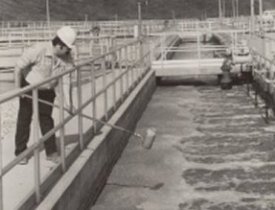The decade of crises reached its climax for MSD in the spring of 1983 with the most serious problem of all: a devastating flood and a total loss of public confidence. The City of Louisville’s report on the May, 1983 flooding was harshly critical of MSD. Elected officials, the news media and individual citizens called for a major overhaul of the way the agency was managed.
In later years, the consensus seemed to be that MSD’s board and managers had focused so intensely on the many problems facing the agency that they had neglected to get the public support needed to do the job. The drainage dispute with the City of Louisville, the continuing problems with the Morris Forman plant, and the impression that MSD was trying to "force" sewers on people who didn’t want them were all parts of MSD’s credibility problem.
Eventually, "anything that went wrong became a symbol of MSD’s inefficiency," recalled former MSD Board member Gerald Neal in 1997. "A lot of the criticism was unfounded, but MSD was not doing a good job of explaining its programs and its challenges."
One of the problems, Neal said, was that the board had not been conducting all of its business in public. Neal, who joined the board in 1979, had been openly critical of this practice. "We were servants of the people," he said later. "How could we justify acting in secret?"
In July, 1983, two members of the Board were replaced — and Neal was elected chairman by a vote of four to three.

MSD Photo by Martin E. Biemer
Public Outreach
MSD had already taken the first steps toward regaining public confidence: The previous month, it had scheduled a series of briefings for public officials and the news media on the problems facing the agency.
By fall, the outreach program had begun in earnest. Members of the board and MSD’s technical staff attended neighborhood meetings to discuss problems and programs with the public. Board meetings were scheduled in a variety of locations, with plenty of room for visitors.
In November, MSD began a series of public forums on major problems and issues: aging combined sewers, cave-ins, sewer expansion needs, the ineffective Morris Forman plant, and stormwater drainage.
In the meantime, the first steps were taken on two of the major challenges facing MSD. In June, 1983, the Board approved a program of repairs and modifications at the Morris Forman plant. That same month, Jefferson Fiscal Court approved a $138,000 revision of the outdated 1974 sewer expansion study.
The Challenges
In January, 1984, MSD named a Strategic Planning and Finance Committee, made up of citizens and elected officials representing all areas of the community affected or potentially affected by MSD. The committee was charged to study MSD’s activities and challenges, then make detailed recommendations for future programs. MSD was asking the community to define what it wanted MSD to do.
As the committee went to work, MSD’s staff presented a comprehensive report of the challenges ahead. The major issues:
- The aging combined storm and sanitary sewer system in the city of Louisville, which overflowed into streams and overloaded the Morris Forman treatment plant during heavy rains.
- The sanitary-only sewer system, including areas served by the Morris Forman plant, the Hite Creek plant, and seven small plants that had been taken over by MSD. Major problems included widespread wet weather overloading caused by stormwater entering the lines.
- The troubled Morris Forman treatment plant, the plan to upgrade it, and the continuing search for better ways to dispose of the solids removed from the wastewater (known to the public as sewage sludge).
- The countywide sanitary sewer expansion plan, revised several times during the past two decades and currently stalled by lack of funding and lack of approval by the U.S. Environmental Protection Agency. (About $50 million in facilities had been installed in southwest Jefferson County, but remained unused because of the enforcement action by the EPA on the Morris Forman treatment plant.)
- Drainage problems, including the fragmented responsibilities among local government agencies and the lack of adequate financing. (Studies already had shown the need for more than 120 drainage projects.)
- The problems of monitoring industrial wastewater, enforcing the limits on the substances it could contain, and dealing with spills of hazardous materials and other industrial waste.
- Financing. Rough estimates, in 1983 dollars, showed a total of $970 million would be needed to carry out the proposed improvements. The breakdown included:
- $333 million for relief sewers and sewer rehabilitation in the Morris Forman plant area;
- $232 million for drainage improvements (not including maintenance costs);
- $270 million for the treatment plants, pump stations and trunk sewers needed for the countywide sanitary sewer expansion program, with only $55 million available from existing funds and grants (the federal government was in the process of reducing its share of these costs);
- $135 million for neighborhood collector sewers for the countywide expansion program.
MSD History continued - Moving forward


